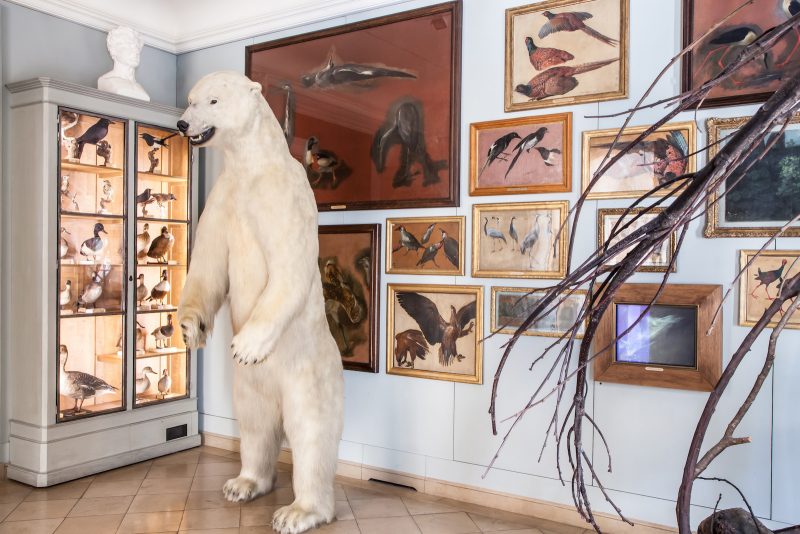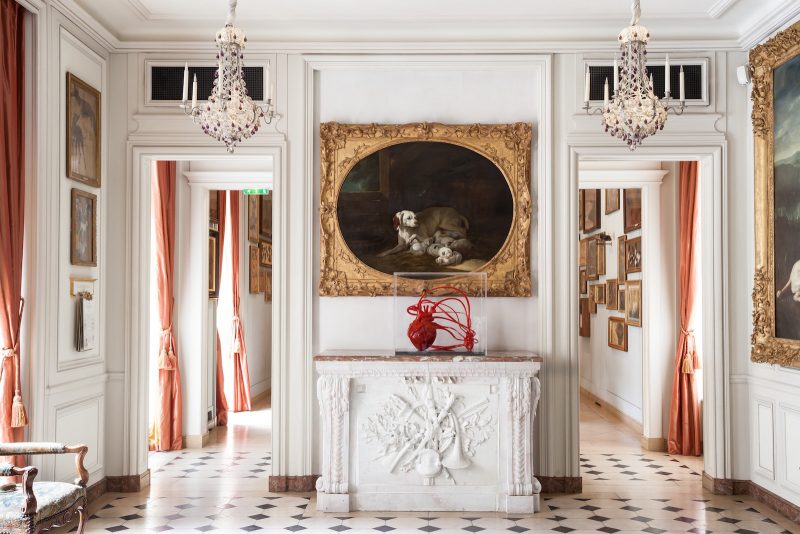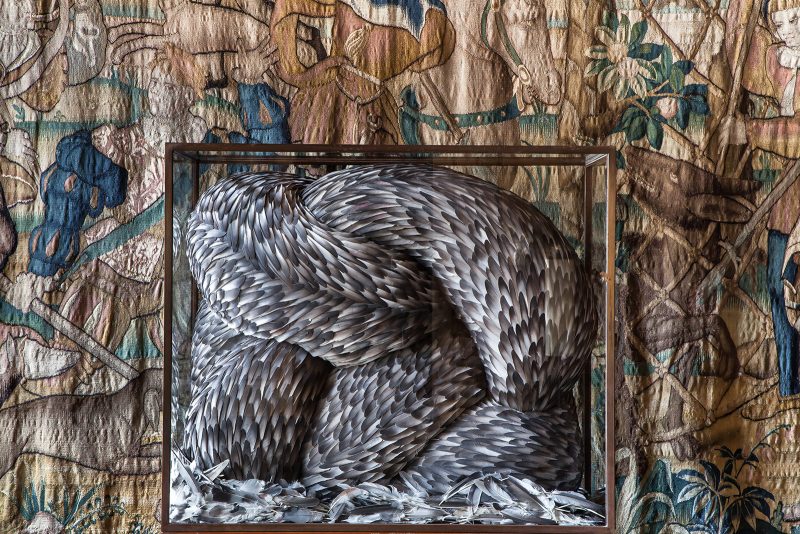
A spooked rooster pokes his head through a ceramic bramble as a gaggle of frightened forest and farm creatures hide and peek from what seems to be a strange fairy tale. Half-hidden and nearly shaking, the faces of these animals betray a narrative of wonder (or fear). This is a world a child might conjure after obsessive readings of Alice in Wonderland, The Secret Garden, or even the fable of Henny Penny.
“La Vie Couvée” (2016) is a key part of the wild porcelain menagerie by French artist Marlène Mocquet, scattered throughout En Plein Coeur, an exhibition of 28 or so table and teapot-sized works matched with 27 paintings at Le Musée de la Chasse et de la Nature in Paris. Intimately imagined, her sculptures and paintings of animals, trolls, spirits, and birds all lost in this nether world are at times savage, humorous, delicate and obtuse. Le Musée de la Chasse is a perfect theater for Mocquet’s rabbit-hole narratives.

House turned museum dedicated to the hunt
The museum, a 17th-century jewel designed by architect François Mansart (1598–1666), is known as a hôtel particulier, a grand town house originally built for Jean-François de Guénégaud des Brosses, Counselor and Secretary to Louis XIII. After a number of incarnations from private home to bureau, in 1964 Le Musée de la Chasse became a highly polished archive devoted to hunting, nature, and man’s history with his animal friends and enemies.

Le Musée de la Chasse is elegantly crammed with hunting paintings, muskets, rifles, weapons of all flavors, a trophy room of tigers, deer, elk, and bear. Throughout the building the eye is treated to gorgeous tapestries, miles of furniture, as well as the prized menagerie of stuffed specimens from the world over. Contemporary artists invited by the museum have over the years consistently offered up focused dialogs on their works and the collection.

Hunting for art
Kate MaccGwire released her chimerical sculptures of feathers in the museum some years ago with Covert, 2014. Her writhing “birds”–snake-like contorted beings–encased in glass vitrines evoked a dark and baffling natural form. American Walton Ford took over the museum a year later with large-scale watercolors of his Audubon-inspired narratives.
Mocquet’s ceramic pieces and paintings are so deftly interspersed in the museum’s rooms, one must literally hunt for them among thousands of objects displayed in cases or on marble armoires, tables, and shelves. A small porcelain work sits inconspicuously amongst other animal sculptures, paintings, and objects, as full bodied taxidermied deer and the famous polar bear linger nearby. There’s a white terrier dog sculpture by Jeff Koons, and one of Kate MccGwire’s works is now part of the permanent collection, but the majority of art works and objects in the museum hail from the 17th, 18th, and 19th centuries and detail the beasts that frightened mankind or served as his supper.

Fear and fascination
Largely created at the Sèvres National Ceramic Manufactory, Mocquet’s “Ciel de chien orageux” (2013) fit right into the collection if only because her universe is rife with the fear and fascination embedded in the hunt and in nature. Here, an imagined garden wall is punctuated with gargoyle-like dogs snarling fiercely at an orphaned strawberry chariot. In other works, birds attempt escape from dogs’ jaws, a boy is trapped in a circle of teeth, a tree is being absorbed by a wolf (or the other way around) on a little hill shared with a sunnyside-up egg–you can almost hear the howling of pain in her “Oeufs au plat fleuris” (2013). The eggs comically distributed among her sculptures are a strange note of birth and beginning to her universe.

These sculptures borrow not only from children’s stories, but also from the allegories painted out in the works of Bosch and Breughel, with a touch of Dante in both the comedy and brimstone to her horror show, particularly in her paintings. In many other works, birds and roosters are stacked up one on the other, as in “Graviter” (2016); large woodland troll-like creatures swallow (or protect?) fellow animals.There’s fright but also some kind of acceptance of the players of their hellish fates.
The paintings offer a more global (if post-apocalyptic) view of Mocquet’s world. For example, in “Captivité” (2016), an oil on paper, we witness a sort of post-apocalypse led by smudgy-faced wide eyed children, some flying (spirits?) and others cowering before a hawk bound to a perch. Hundreds of spectral beings are often gathered around some scene of ablution or offering (an apple is common) as armies gather and descend or align themselves.
Mocquet (born in 1979) details coded legends of supernatural beings as they play out dramas of birth and death and the complex relationship between man and beast in a fervent, delicious chaos. After two hours with the artist’s works and the museum’s own collection, one is left with a disquieting pleasure not unlike witnessing a colony of ants devouring a slug or a worm. And if you look closely you can see your own life being served up to hungry mouths.
Le Musée de la Chasse et de la Nature, 62, rue des Archives, 75003 Paris, France. En Plein Coeur is on view through June 4.









